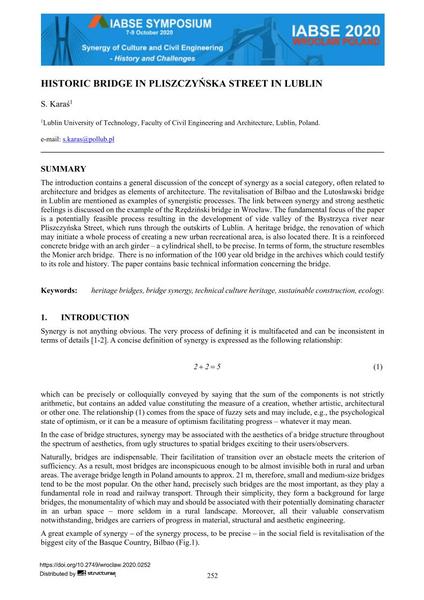Historic Bridge in Pliszczynska Street in Lublin

|
|
|||||||||||
Bibliographic Details
| Author(s): |
S. Karaś
|
||||
|---|---|---|---|---|---|
| Medium: | conference paper | ||||
| Language(s): | English | ||||
| Conference: | IABSE Symposium: Synergy of Culture and Civil Engineering – History and Challenges, Wrocław, Poland, 7-9 October 2020 | ||||
| Published in: | IABSE Symposium Wroclaw 2020 | ||||
|
|||||
| Page(s): | 252-259 | ||||
| Total no. of pages: | 8 | ||||
| Year: | 2020 | ||||
| DOI: | 10.2749/wroclaw.2020.0252 | ||||
| Abstract: |
The introduction contains a general discussion of the concept of synergy as a social category, often related to architecture and bridges as elements of architecture. The revitalisation of Bilbao and the Lutosławski bridge in Lublin are mentioned as examples of synergistic processes. The link between synergy and strong aesthetic feelings is discussed on the example of the Rzędziński bridge in Wrocław. The fundamental focus of the paper is a potentially feasible process resulting in the development of vide valley of the Bystrzyca river near Pliszczyńska Street, which runs through the outskirts of Lublin. A heritage bridge, the renovation of which may initiate a whole process of creating a new urban recreational area, is also located there. It is a reinforced concrete bridge with an arch girder – a cylindrical shell, to be precise. In terms of form, the structure resembles the Monier arch bridge. There is no information of the 100 year old bridge in the archives which could testify to its role and history. The paper contains basic technical information concerning the bridge. |
||||
| Keywords: |
ecology sustainable construction Heritage Bridges bridge synergy technical culture heritage
|
||||
